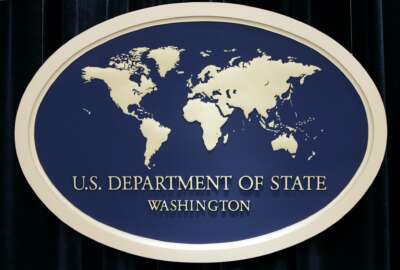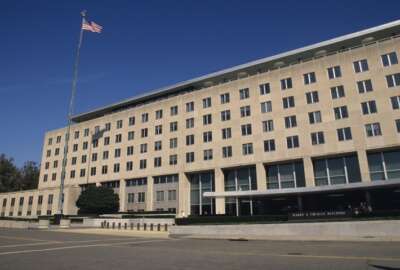

As the Biden administration gets up and running, the president's pick to run the State Department sees an opportunity to revitalize its workforce.
As the Biden administration gets up and running, the president’s pick to run the State Department sees an opportunity to revitalize its workforce.
Antony Blinken, President Joe Biden’s nominee for secretary of state who was confirmed Tuesday, told the Senate Foreign Relations Committee last week that workforce attrition and a decline in morale has left the agency with about 1,000 fewer employees than it had four years ago.
That workforce reduction stems in part from a 16-month hiring freeze led by former Secretary of State Rex Tillerson.
While the Trump administration’s second Secretary of State Mike Pompeo lifted the hiring freeze early in his tenure and sought to bring “swagger” back to the agency, a recent report from the Partnership for Public Service found the agency saw its first net staff reduction in decades under President Donald Trump.
The report also shows a steady decrease in employee satisfaction scores over the past decade, as measured by the Partnership’s annual Best Places to Work in the Federal Government rankings.
In addition to recruiting the next generation of diplomats, Blinken told the lawmakers he’s committed to revitalizing diversity and inclusion efforts that had been on hold by the Trump administration.
“It’s not simply a matter of bringing people back, filling the slots that are now empty. It’s making sure that to the best of our ability, we’re building a workforce that has the skill set to deal with the incredibly complex challenges that we’re facing — that are very different than the challenges we faced in previous generations,” Blinken said.
Blinken told the committee that he would likely seek additional hiring authorities and increased flexibility to add employees to the agency’s ranks.
Chris Cox, a former senior intelligence service executive, now a senior adviser with the Partnership, said the agency should consider recruiting the next generation of talent through clearer career paths and shorter career arcs for employees with technical skills.
“Not everyone is looking for that 30-year career,” Cox said in an interview. “Having those different opportunities will attract talent, and many younger people in the job market seek jobs that offer strong professional development opportunities and state-of-the-art technology. Both are areas where the department needs to make some gains and is seeking to do so.”
The Biden administration, however, will inherit problems that precede the Trump administration. The Government Accountability Office found overall workforce diversity has improved at the agency, but also concluded that racial minorities were less likely to receive promotions than their white colleagues.
GAO issued its latest report in January 2020, but its findings reflect many of the same underrepresentation issues GAO identified back in 1989.
The Partnership’s report highlights short-term goals in hiring, retention and professional development where the Biden administration can see the most immediate results. But even in those cases, Cox said the agency won’t be able to replace the valuable diplomatic experience it lost overnight.
“Attrition can deplete the department’s institutional knowledge, as well as the diplomatic relationships that are important to foreign policy work. These kinds of resources can take years to develop through these civil servants and Foreign Service officers, and backfilling a position doesn’t necessarily compensate for the knowledge gap caused through attrition,” Cox said.
Committee Chairman Bob Menendez (D-N.J.) said the decline in State Department staffing has impacted the agency’s international relationships, its work with other federal agencies and its communications with Congress.
“There has been a stunning loss of expertise, steep declines in morale, little accountability for those at the top, and the State Department still has not achieved a workforce that comes close to reflecting the diversity of our country,” Menendez said.
The Biden administration can build off some of the workforce initiatives started under Pompeo’s tenure. In that time, former Undersecretary for Management Brian Bulatao oversaw several initiatives in talent management, security, infrastructure, innovation and data analytics that saw some interest from career employees.
Bulatao, for example, oversaw efforts to stand up the agency’s Center for Analytics last year, and in the final days of the Trump administration, the agency named former Department of Homeland Security executive Matthew Graviss as its first permanent chief data officer.
“Despite the lack of time on target — meaning Undersecretary Bulatao’s time on the job — and some strained resources, some gains were made,” Cox said.
Bulatao also led a task force behind the agency’s latest diversity and inclusion strategy, but President Trump effectively put those actions on hold through an executive order he signed last year.
Last week, however, President Biden signed his own executive order overturning Trump’s hold on diversity and inclusion training for federal employees, contractors and grantees, pending a governmentwide review.
State Department spokesman Ned Price said in a statement Friday that the agency has fully reinstated employee training and professional development that supports diversity, equity and inclusion.
Blinken told the committee that, if confirmed, he would name a chief diversity officer that would set benchmarks for diversifying the agency’s workforce and share those updates with Congress.
“I will view it as a significant measure of whether I succeeded or failed, however long I’m in the job, whether or not we have finally put in place the real foundations to make sure that we have a workforce in the State Department that looks like the country it represents,” Blinken said.
Meanwhile, the Partnership has identified long-term challenges at the agency that the Biden administration can start to change course. Cox said the agency has long relied on a leadership culture built on centralized authority that doesn’t effectively delegate decision-making.
“We’re seeing decisions very consistently rising way too high in the organization, often to the assistant secretary, which slows things down,” Cox said.
Meanwhile, political appointees occupy more agency leadership roles than ever before. In 1975, career foreign service officers filled 60% of agency positions at the assistant secretary level or higher. But late last year, confirmed or acting career staff held only 21% of those positions.
Cox said career employees and political appointees both bring expertise to the agency, and can work together to improve conditions if there is a balance between them.
“Political appointees, who bring alignment with the administration and bring great outside expertise, combined with those career leaders who have that institutional knowledge and those strategic relationships – together they’re very powerful. But they’ve come out of balance recently,” Cox said.
Copyright © 2025 Federal News Network. All rights reserved. This website is not intended for users located within the European Economic Area.
Jory Heckman is a reporter at Federal News Network covering U.S. Postal Service, IRS, big data and technology issues.
Follow @jheckmanWFED



